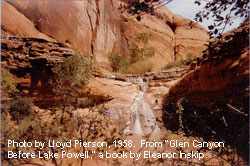 |
|

The incredible change of the Colorado ecosystem was due to, originally, the Colorado River Storage Project (CRSP) and Act (1956) which sought to provide water and energy to the rapidly growing desert area of the Four Corners and Las Vegas. The Glen Canyon Dam was considered to be the "crown jewel" (USBR & USDOI, 1996) of the project. In 1956 construction of the dam began and was completed a mere eight years later. It would take a little more than twice that time, 17 years, for the reservoir to reach its optimal capacity (NPS, 1998). However, this was a time before environmental movements and laws when little was understood or known about human impact on nature and ecosystems. Extensive geological research was completed on numerous canyons to find the perfect site sitting amid the shadows of other great Colorado dams, specifically the infamous and enormous Hoover Dam, and the few concerns of "possible" ecological impacts were quickly dismissed as "costs of progress" (PBS, 1997). No environmental assessments were implemented to study the possible impacts this enormous concrete plug would have on the river and the 186 miles of canyon it was scheduled to submerge (PBS, 1997). In fact, some say that it was the building of Glen Canyon Dam and the consequent destruction of the Glen Canyon/Colorado River ecosystem which kicked off the environmental movement with the emergence of leaders like David Brower, founder of the Sierra Club, and with the formation of private organizations like the Glen Canyon Institute (GCI) (GCI, 1998).
Later, growing public concerns over the health of the system (USBR & USDOI, 1996) led USBR administrators and government officials to an environmentally conscious shift in their minds and agendas. They did so by creating the Glen Canyon Environmental Studies (GCES) program in December of 1982, recently renamed the Grand Canyon Monitoring and Research Center. Using funds from the CRSP, the GCES employs a multi-disciplinary approach to assess the implications of the dam on the system and to respond to public concerns. Further legislation drafted the Grand Canyon Protection Act (1992) which required, by section 1804 (a), that an Environmental Impact Statement (EIS) be completed on Glen Canyon by October 30, 1994. The EIS, a project of both the USBR and the GCES, focused on two main impacts of the dam and their implications; flow patterns and sediment transport. Published in 1996, the EIS considers a variety of modifications to way the dam currently functions and alternatives to the dam itself, as well as the respective ecological imapcts of each to the system. There are many more groups, both federally and privately administered, which seek to study the environment in order to help maintain its health and better predict the ways in which our future actions may affect it.
 |
|